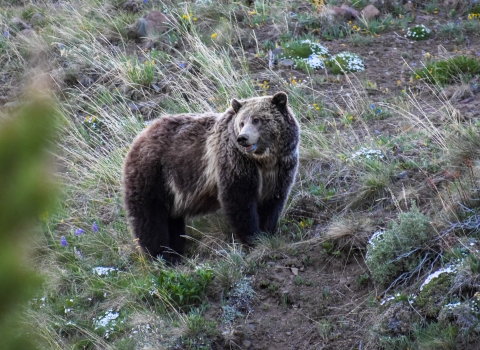Furthering the Trump Administration’s objectives to balance effective, science-based conservation with commonsense policymaking, the U.S. Fish and Wildlife Service (Service) is proposing regulations to clarify and update its processes for considering exclusions from critical habitat designations under the Endangered Species Act (ESA). The proposed changes relate to the Service’s recent announcement on the proposed definition of habitat and respond to a 2018 Supreme Court decision in the Weyerhauser case, as well as codifying and modifying current agency practices.
“The Trump Administration is focused on improving the implementation of the Endangered Species Act and working with stakeholders and the public to recover imperiled species. The proposed regulations would provide greater transparency for the public, improve consistency and predictability for stakeholders affected by ESA determinations and stimulate more effective conservation on the ground,” said Service Director Aurelia Skipwith.
This rulemaking action demonstrates Secretary of the Interior David L. Bernhardt’s responsiveness to public concerns about the impacts of critical habitat designation by committing to always undertake an analysis when a proponent of an exclusion presents credible information supporting their case.
“As partners in wildlife conservation, counties are well positioned to offer practical insights into improving the Endangered Species Act,” said National Association of Counties Executive Director Matthew Chase. “We look forward to continuing to work with our federal partners to reduce unnecessary regulations while achieving our shared infrastructure, community development and environmental stewardship goals. We also encourage local governments to examine and comment on the proposed rule to revise the ESA.”
Section 4(b)(2) of the ESA gives the Secretary of the Interior the authority to exclude any particular area from a critical habitat designation if the benefits of exclusion outweigh the benefits of inclusion for that area, so long as excluding the habitat will not result in the species’ extinction.
The proposed rule provides the framework for how the Service will take into consideration the economic impact, impact on national security and other relevant impacts of designating critical habitat. Additionally, the proposed regulations would provide categories of “other relevant impacts” that the Service may consider, including public health and safety, community interests and the environment, such as increased risk of wildfire or pest and invasive species invasive species
An invasive species is any plant or animal that has spread or been introduced into a new area where they are, or could, cause harm to the environment, economy, or human, animal, or plant health. Their unwelcome presence can destroy ecosystems and cost millions of dollars.
Learn more about invasive species management.
For example, a local community could propose an exclusion because the area is the site of a planned hospital or school. In that case, the Service would determine whether the benefits of building the hospital or school outweigh the benefits of including the area as part of the critical habitat. However, the Service will not grant an exclusion of a particular area as critical habitat if it would cause the extinction of the species.
A local government could propose the exclusion of a particular area based upon environmental concern, such as a catastrophic wildfire, or a Tribal government could request an exclusion of a particular area based upon the needs and concerns of the Tribe and Tribal sovereignty. Again, the Service in making these determinations an exclusion cannot be granted if it would cause the extinction of the species.
The proposed rule also recognizes that State, local and Tribal governments, private landowners and permittees and lessees on public lands may have credible information regarding the impacts of a proposed designation of critical habitat. It specifically seeks their input on those designations impacting them.
The proposed rule would not affect how the Service administers the ESA within areas that currently are designated as critical habitat, which are areas identified as essential to a species’ conservation and recovery and containing one or more physical or biological features. The ESA’s language makes clear that the conservation needs of the species drive the initial step of identifying critical habitat and expressly requires designations to be made based on the best scientific data available.
The proposed rule will be published in the Federal Register, and public comments will be accepted for 30 days upon its publication. The Service will post all comments online. This generally means the agency will post any personal information provided through the process. The Service is not able to accept comments sent by email or fax.
Additional Background on ESA Improvements and Accomplishments
To support stronger on-the-ground conservation efforts, encourage private actions to benefit our most imperiled species and provide greater legal certainty for ESA determinations, the Service and the Department of Commerce’s National Marine Fisheries Service updated its ESA regulations in 2019 to improve the implementation of the law. The regulations hadn’t been comprehensively updated since the ESA passed some forty years ago. The Service’s guidepost for the multi-year, public process was President Trump's overarching effort to reduce regulatory burden without sacrificing protections for the environment and wildlife.
No administration in history has recovered more imperiled species in their first term than the Trump Administration. Since 2017, eleven species have fully recovered, no longer being listed on the Endangered Species Act (ESA) list, and another six species have been downlisted from endangered to threatened. To provide context for this in looking at other administrations in their first term, the Obama Administration recovered six species; the Bush Administration recovered eight species; and the Clinton Administration recovered nine species.
Today’s proposal would further the progress made so far to improve the recovery of imperiled species, facilitate better collaboration with public and private stakeholders and bring greater clarity to the law.



